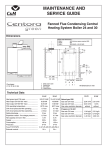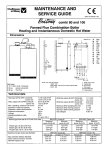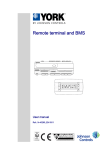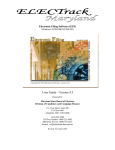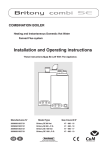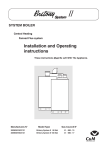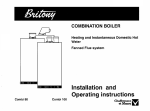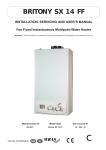Download Chaffoteaux & Maury Britony System 60 Technical data
Transcript
C MAINTENANCE AND SERVICE GUIDE system II Plus 80 and 100 Central Heating Fanned Flue Boiler Dimensions Sizes in mm Boiler outer case dimensions : - Height : 850 - Boiler width : 440 (minimum space required 450) - Depth : 380 Flue types: C 12 or 42: horizontal C 32 xx: vertical concentric C 32 xy: Twin flue I J K L N Safety valve outlet Heating flow H.W. flow Gas supply Heating return Technical data Heat input C/H & HW System 80 : System 100 : Heat output C/H & HW System 80 : System 100 : Max. operating pressure C/H circuit : Expansion vessel net capacity : : Expansion vessel initial pressure 11.73 to 28,70 kW 15.43 to 34.50 kW 9.50 to 24 kW 12.50 to 28 kW 2.5 bar 5.4 l 0.7 bar Electrical consumption Voltage Electrical protection index Fuses Gas category : : : : : 150 w 230 v IP24 2 A and 1.25 A II 2H+ 3+ Nominal gas flow rate at 15°C and 1013 mbar BRITONY System II Plus 80 Maximum Minimum power kW power kW BRITONY System II Plus 100 Maximum Minimum power kW power kW -Natural gas ( G 20) at 20 mbar -Butane gas ( G 30 ) at 28 mbar -Propane gas ( G 31 ) at 37 mbar 2.74 m3/h 2.04 kg/h 2.00 kg/h 3.34 m3/h 2.45 kg/h 2.42 kg/h -Blue solenoid restrictor diameter -Gas valve restrictor diameter -Manifold injectors (16) 1.57 m3/h 1.17 kg/h 1.15 kg/h 11 mbar 35 mbar 26.7 mbar 12.8 mbar 30.4 mbar 24 mbar BRITONY System II Plus 80 Butane or Propane Natural gas BRITONY System II Plus 100 Butane or Propane Natural gas -Nominal Burner Pressure (NG - G20) -Nominal Burner Pressure (Propane L.P.G. - G31) -Nominal Burner Pressure (Butane L.P.G. - G30) Injectors and gas valves seat diameter 1.22 m3/h 0.91 kg/h 0.89 kg/h 2.60 mm 6.70 mm 1.23 mm 1.75 mm 4.90 mm 0.70 mm 2.90 mm no restrictor required 1.26 mm 2.00 mm 6.70 mm 0.76 mm Pump and expanssion vessel characteristics PUMP HEAD AVAILABLE disponible MinimumPression flow rate (with all heating thermostatic valves closed) mCE Débit mini (robinets thermostatiques fermés) m CE 5 1 4 3 2 2 1 Flow Débit 0 100 200 300 400 500 600 700 800 900 1000 1100 l/h 1 = by-pass closed 2 = by-pass open Note : The system initial pressure should be over the following value : System static height (in metre) + 0.7 = Initial pressure (in bar) 10 Head available / flow Components location 7. Pressure relief valve 8. Chassis 9. Connecting tails (x 5) 1. CH Flow isolating valve 2. HW Flow isolating valve 3. Gas service tap 5. CH Return isolating valve 1 3 0 4 bar 8 1 10. Steel chassis complete with expansion vessel 11. Sealed chamber 12. Expansion vessel (not visible) 13. Overheat thermostat 14. Electrical box 15. Two position selector switch 17. Heating flow temperature adjustment 18. CH pressure gauge 20. Green indicator - Power ON 21. Orange indicator - Burner ON 22. Red indicator - Lock out / flame failure 23. Reset button 2 2 3 9 5 24. Multigas burner comprising: -25. 16 burner head -26. Manifold -27. 2 Ignition electrode -28. Ionization electrode 29. Gas section comprising: -30. Security valve (grey) -31. 1/3 gas stage (blue) -32. 2/3 gas stage (black) 33. Right hydraulic assy 34. Left hydraulic assy 35. Pump 36. Air separator 37. Heating thermistor 7 39. Combustion chamber made of aluminium coated steel with 4 ceramic fibre panels to insure heat insulation 40. Copper main exchanger 42. Three way valve 43. Connecting bracket 45. Heating flowstat 46. Flue hood 47. Adjustable by-pass 49. Air Pressure switch 50. 45° elbow including venturi 51. Fan K. Flue kit fixing point (refer to kit manual) FUNCTIONING Switching on 1) Check that the gas service tap is opened at the gasmeter and main power is on. 2) Check that pressure in central heating system is above 0.7 bar and COMPONENTS LOCATION 50 K 49 51 below 2.5 bar with the pressure gauge 18. 3) Open the gas tap 3 by turning from right to left. 12 4) The boiler is now ready to use. Hot Water 10 1) Turn selector switch 15 to position 46 cator 40 The green "power on" indi- (20) will light. 2) The orange "burner on" indicator (21) will light and the cylinder- will be heated. 11 Heating and Hot Water 25 1) Turn selector switch 15 to position 39 indicator 26 . The green "power on" will light.(20) 2) If the room thermostat (if fitted), the boiler temperature control 24 and the clock (if fitted) are all calling for heat, the orange "burner 29 on" indicator 36 13 will light and the heating will be on. Control panel 33 23 22 34 45 14 35 C 15 17 20 21 18 BRITONY System II plus FUNCTIONAL DIAGRAM 50 51 49 40 39 28 27 24 13 29 12 14 32 31 30 45 37 42 36 35 47 5 1 2 3 7 43 Heating mode storage tank 3 When there is a need for hot water tank reheating while the heating is on. The heating will be interrupted momentarily while tank is reheated. The boiler will switch back automatically to heating when the tank is at temperature. Note: If the boiler has been turned off for some time the first attempt to light it may result in a lockout . 22 . If this happens press the reset button 23 and the boiler will light. Domestic Hot Water Mode To be able to supply hot water, the selector switch 15 must be in either on or position. This will be confirmed 20 by the green indicator light When the aquastat of the tank is on, it activates the DHW flow switch 44 and allow the 3 way valve 42 to move to the HW position. The pump can now circulate primary water heated by the main heat exchanger through the tank heat exchanger. The first stage solenoid 31 (blue) and security solenoid 30 (grey) open together to allow gas to the burner. The ignition sequence begins and a continuous high speed spark ignites the gas. As soon as a flame is detected the orange indicator bulb 21 will light and the second stage solenoid 32 (black) opens to allow the full gas rate. If a flame is not detected, after 8 seconds, the security solenoid closes and shuts off the gas. The red lockout indicator bulb 22 will light. The water flow temperature is controlled by the central heating control thermistor 37. When the tank is at temperature, the burner is extinguished and the pump stops. The boiler will now stay in the hot water mode for three minutes. Priority will be given to a demand for hot water tank reheating. This will interrupt the central heating for the duration of hot water tank reheating. Central Heating Mode To be able to supply heating, the selector position. switch 15 must be on This will be confirmed by the green indi20. cator light When there is a demand for heating (either from the room thermostat or the clock) the pump starts. If the boiler temperature control is calling for heat and primary flow rate over 4 ltr/min, the central heating flow switch operates allowing the ignition sequence to begin. The first stage solenoid 31 (blue) and security solenoid 30 (grey) open together to allow gas to the burner. The ignition sequence begins and a continuous high speed spark ignites the gas. As soon as a flame is detected the orange indicator bulb 21 will light. After 45 seconds the second stage solenoid 32 (black) opens to allow the full gas rate. If a flame is not detected, after 8 seconds, the security solenoid closes and shuts off the gas. The red lockout indicator bulb 22 will light. The central heating flow temperature is controlled by the central heating control thermistor 37. The boiler has been designed to minimise cycling and will not attempt to relight for at least 3 minutes after the boiler thermostat has been satisfied. When the room thermostat is satisfied the burner will switch off and the pump will remain running for a further 3 minutes before it too stops. NB It is possible to override the 3 minute delay by pressing the RESET button 23. Lock out procedure Flame disappearance : When the ionisation electrode 28 does not detect flame presence. The orange indicator lamp 21 extinguishes. A lighting cycle starts. If a flame is not detected before 8 seconds, the grey security solenoid 30 and the blue 1/3 solenoid 31will close. The lock out red indicator 22 lights, the pump 35 runs and the 3 way valve 42 stays in its position. After a few seconds, it will become possible to reset the boiler by pressing the reset button 23. Overheat detection : If an overheat is detected by the sensor 13, the grey security solenoid 30 and the blue 1/3 31 closes, the orange indicator lamp 21 extinguishes. The ignitor is energised for 8 seconds and the red lockout indicator 22 ligths. If the burner cannot relight the boiler will go to lockout. WIRING Plug for main power and Room thermostat connection DIAGRAM 1 2 3 4 5 1. Neutral 2. Phase 3. Room thermostat live 4. Accelerator resistor 5. Common for Accelerator and room thermostat. 4 ELECTRICAL WIRING continuation N° 13. 14. 14a. 14b. 14c. 14d. 14e. 14f. 14g. 18. 27. 28. 30. 31. 32. 35. 37. 38. 42. 44. 45. 51. Designation -Overheat sensor -Electrical box -Regulation PCB -Ignitor -Fuse 1.25 A -Fuse 2A -Power PCB -Room thermostat -Mains 230V 50 Hz -Pressure switch Wiring colours Brown Red, Black 2: Black P: Orange 1: White -Spark electrodes White -Ionisation probe White -Security solenoid (grey) Grey -2/3 gas stage solenoid (black) Black -1/3 gas stage solenoid (blue) Blue -Pump -C/H thermistor Violet -DHW thermistor Green -3 way valve White, Yellow, Orange -DHW flow switch Brown -C/H flow switch Red -Fan Brown, Blue REGULATION Temperature regulation for both C/H and DHW circuits are controlled by 2 thermistors. The C/H knob allows the adjustment of temperature between 35 and 85°C. The DHW temperature is limited to 60°C. DHW and C/H thermistors are identical and interchangeable. Resistance value are -5000 Ω at 25 °C -2631 Ω at 40°C -620 Ω at 80°C -255 Ω at 110°C FLOW SWITCHES Flow in both D.H.W. and Heating circuits are detected by 2 flow switches. A piston with a magnet at the top operates a REED switch. The piston is lifted by flow rates listed below : Flow rate threshold : D.H.W. 120 l/h ±20 l/h C/H 250 l/h ±20 l/h AIR PRESSURE SWITCH The air flow rate is detected by a pressure differential created by a venturi located in the flue duct. ON threshold OFF threshold ∆P > 130 Pa ∆P < 100 Pa ADJUSTMENTS ON CONTROL PCB The following adjustments are available on the regulation PCB. To gain access to them, pivot down electrical box, remove the rear cover and the rear panel of electrical box, unplug connectors from regulation PCB and pull it toward you. Heating output limitation : - Functioning without limitation - Functioning at 1/3 gas rate only plug C on "P MAX" plug C on "P 1/3" Burner functioning: - Regulation available 3/3, 1/3, 0 - Functioning at full gas rate only plug D on "NOR" plug D on "TUR" D C ROUTINE SERVICING To ensure continued efficient operation of the appliance, it is recommended that it is checked and serviced as necessary at regular intervals. The frequency of servicing will depend upon the particular installation condition and usage, but in general, once a year should be adequate. It is the law that any service work must be carried out by a competent person such as your local Chaffoteaux Service Centre, British Gas or other CORGI registered personnel in accordance with the current Gas Safety (Installation and Use) Regulations. - Check burner pressure and gas flow rates. - Check that the fan blades are clean. - Check, clean and replace components as necessary. - Carry out combustion test utilising the test points in the flue turret. SUGGESTED SEQUENCE for SERVICING Before disconnecting or removing any parts, isolate the gas and electricity supplies. Ensure that the appliance is cool. The service schedule should include the following operations: (for detail please see section on Parts Removal and Replacement) - Check the pressure in the system by checking the reading on the pressure guage (No. 18 Control Panel - Page 3). - Check the correct operation of the appliance (see Page 4 - Domestic Hot Water Mode and Central Heating Mode). - Check the correct operation of the gas controls. - Check the functions of the safety controls. - Check combustion chamber insulation panels for damage. - Clean the burner. - Clean the heat exchanger. - Check the burner manifold injectors. - Clean gas and water filters. - Check expansion vessel charge pressure. - Clean and check operation of safety valve. Preliminary Checks - Remove outer case - Check the system pressure is at least 0.7 bar cold - Check operation of 1/3 and 2/3 solenoids. - Check that the burner is extinguished fully when both solenoids are closed in both DHW and C/H modes. - Test ionisation functions and check that lockout occurs by turning off gas tap. - Whilst boiler is operating, check operation of primary flow switch by closing heating flow valve and by pass screw (turn clockwise) noting the number of turns so that it may be reset correctly. Additional Procedures that may be necessary: 5 REMOVAL AND REPLACEMENT OF PARTS Before removing appliance case, isolate the gas and electrical supplies. Isolate boiler from the system and drain before removing any component in the waterways. Ensure that the appliance is cool. 1. Outer Case Remove four screws in base of case 5. Ignition Electrodes Carry out steps 1 and 2 as above. Hinge down electrical box by pressing retaining tabs P on either side. P 10. Pressure Switch Remove outer case and sealed chamber front panel as in steps 1 and 2. Disconnect three pressure switch cables noting their positions. 1 = white cable connected to NC 2 = black cable connected to NO P = orange cable connected to C 1 C A A A A andlift free. When replacing, carefully locate on lugs T on top edge of chassis. T T T T 1 2 P Remove wiring cover C. Disconnect leads from spark generator. Loosen screws securing the closure plate and remove. Remove grommet from base of sealed chamber. Remove screw securing electrode bracket and lift clear easing spade connectors through the grommet. Reassemble in reverse order, twisted together electrodes cable at least 10 times to avoid electrical interference. 6. Burner Assembly Carry out steps 1,2, disconnect electrodes as mentionned in section 4 and 5. Remove two screws securing burner assembly to the back panel of the boiler. Lift right hand back corner first. Reassemble in reverse order. 7. Gas Solenoids Disconnect colour coded leads. Remove six screws. The solenoids are attached to their base plate. Lift clear taking care not to lose the three plungers and springs. Reassemble in reverse order replacing the cork gasket. 2. Combustion Chamber Unscrew four self tapping screws securing the sealed chamber front panel and lift over top corner locating lugs. Unscrew four self tapping screws to release combustion chamber front plate and lift clear. Reassemble in reverse order. 3. Burner Manifold Carry out steps 1 and 2 as above. Remove two screws securing the closure plate and the remaining four screws to release the manifold. Lift clear. Replace the manifold gasket. Reassemble in reverse order. 4. Ionisation Electrodes Carry out steps 1 and 2 as above. Loosen screws securing the closure plate and remove. Disconnect the lead from the main wiring loom. Remove screw securing electrode to burner. Thread wire through grommet and lift clear. Reassemble in reverse order. 6 2 8. Fan Assembly Remove the outer case and sealed chamber front panel (See Steps 1 and 2). Disconnect spade connectors noting positions. Remove the screw securing the front of the fan assembly and loosen the grub screw on the flue outlet. Twist fan assembly anticlockwise to disengage from flue outlet and lift clear. Re-assemble in the reverse order ensuring that the wiring is re-connected correctly and the screw on the flue outlet tightened. 9. Flue Hood Carry out steps 1 and 2 as above. Remove fan assembly as in step 8. Remove the three screws securing the angled top of the hood to the chassis. Lift and remove taking care not to snag the pressure switch cables. Re-assemble in the reverse order ensuring that the hood is located behind the combustion chamber rear panel. P Remove screw securing the switch bracket to the chassis. Disconnect the sampling tubes again noting their positioning (+ and -). Remove switch. Reassemble in reverse order. 11. Pressure Switch Venturi Carry out steps 1, 2 and 8, as above. Disconnect the sampling tubes and remove the screw securing the venturi to the flue outlet. Remove venturi by the bottom of the 45° elbow. Reassemble in reverse order. 12. Drain down 2 drain points are located on the boiler. H = Heating circuit drain point (air separator) H 13. Water filter The C/H filter is located in the right hydraulic assembly. Remove the return pipe as described previously and withdraw the filter. Reassemble in reverse order. 14. Flow switch Drain boiler as in step 12. Disconnect the electrical plug, turn the top cover anticlockwise, remove the O-ring and the brass piston. Reassemble in reverse order. 15. 3-Way valve Drain boiler as in step 12. Remove the 3 clips on the 3 way valve. Remove the clip on the exchanger flow pipe. Pull the pipe down then pull it out of the 3 way valve. Disconnect the plug from the motor. Unscrew the nut on the pipe between the connecting bracket and the 3 way valve and pull it toward you. Rotate the 3 way valve body anti-clockwise to unclip it from the left hydraulic assembly. 17. Main heat exchanger Carry out steps 1 and 2 as above. Drain boiler as in step 12. Remove the 2 clips E located on return and flow pipes and pull them downwards. Pull the main exchanger toward you to remove. Reassemble in reverse order. Unscrew the nut F of the return pipe from the volute. Remove the clip G on the pump volute and pull pump toward you. Reassemble in reverse order. 19. Pressure relief valve The pressure relief valve can be serviced from the front of the appliance. Drain the boiler first, undo the retaining screw and pull out the valve.Reassemble in reverse order. 20. Thermistor Drain the boiler as step 12. Disconnect the plug, remove the retaining clip pull the thermistor out. Reassemble in reverse order. 37 23. Power board Carry out steps 1, 2, and open the electrical box cover as mentionned in step 5. Undo the 4 screws of the electrical rear panel and remove it. Unplug all cables from the PCB, remove earth plug from earth socket. Hang out the power board. Reassemble in reverse order. 24. Control board Pull out plastic knob from the front panel and proceed as step 23. Reassemble in reverse order. 25. Expansion vessel Remove the casing as step 1 and drain the boiler as step 12 above. Unscrew the connecting tails nuts and lift out the boiler from the wall. Place it on a side on the floor. Remove the expansion vessel bracket retaining screws, disconnect the pipe from the vessel and pull ti toward you. Reassemble in reverse order. 37 = Heating thermistor 21. Safety thermostat Remove the casing as step 1 and hinge down the electrical box as step 5. Disconnect the 2 cables, pull out the sensor with the clip 13. 13 E 18. Pump Drain boiler as in step 12. Pivot the electical box downwards. Open the electrical box cover removing the 2 screws. Remove the pump plug from the power board and earth plug from earth socket. G F Reassemble in reverse order. 22. Spark generator Carry out steps 1, 2, and open the electrical box cover as mentionned in step 5. Undo the 4 screws of the electrical rear panel and remove it. Unplug electrodes wires, remove the ignitor connector from the PCB, remove earth plug from earth socket. Hang out the ignitor. Reassemble in reverse order. 7 8 Release pump rotor - Replace control PCB or driver PCB - Check mains electrical connection - Check internal fuses - Check connection between the 2 PCBs No No Ok Yes No Ok No Does the red LED light ? Replace driver or control PCB Replace pump Ok Check that the pump spins freely Ok Check voltage in the pump electrical box - Press the RESET button Yes Replace pressure switch Replace heating thermistor Check or replace main heat exchanger. It could be fully scaled Replace heating flow switch Does the pump run ? No - Press the RESET button to cancel the 3 min. delay. - Ensure that external controls are calling for heat. - Rotate heating control knob clockwise to the maximum position. Does the green LED light ? Put the SELECTOR switch on position Yes No No No No No Check voltage on the fan Ok Check air pressure switch continuity between P and 1 Ok Check heating thermistor Ok Check flow in the boiler primary circuit Ok Check heating flow switch No Does the fan run ? means a group of actions means an action means a test or a choice FAULT FINDING CHART Part 1 Ok Yes Replace fan assembly Replace spark generator or ignition electrods assembly - Check pressure probes or - Check flue duct condition or - Replace pressure switch Yes No Replace driver or control PCB No Does the spark generator energize ? Ok Check air pressure switch continuity between P and 2 No Could you hear the spark generation ? Yes PLEASE CHECK THE FOLLOWING POINTS CAREFULLY BEFORE GOING THROUGH THE FAULT FINDING CHART - Gas pressure - Electric mains - Minimum water pressure in the heating circuit (over 0.8 bar) - All isolating valves have been opened - boiler air vented - Check that the heating filter is clear. 9 Replace electrode assembly Replace gas solenoïd assembly Replace driver PCB Check if an overheat occur or replace overheat sensor Replace control or driver PCB Replace control PCB because orange LED is deffective No No No No No Yes Replace driver PCB Ok Check the ionization electrode Yes Is there a gas pressure at manifold ? Yes Do the gas solenoïds energize ? Press the RESET button Yes Does overheat contact close ? Yes Check flow in the boiler primary circuit No Does the burner light for more than 8 sec. ? No Does the orange LED light ? Yes Replace control PCB Yes The boiler is OK No Does the orange LED light ? Wait until the return pipe become hot then rotate the heating control knob anticlockwise to minimum The heating outlet pipe temperature rise FAULT FINDING CHART Part 2 SHORT LIST 104 547 110 402 615 560 111 616 505 113 572 627 629 510 805 605 514 206 606 607 532 636 938 216 Key N° Description G.C N° Manf. Pt. N° Type FF FF 104 OVERHEAT THERMOSTAT 100°C 277783 110 IGNITION ELECTRODE ASSY 277788 1002801 111 IONIZATION ELECTRODE 277789 1002802 113 HEAT EXCHANGER 277790 1010017 HEAT EXCHANGER E00606 206 216 1010572 1011136 FAN ASSY 1304720 FAN ASSY 1304721 AIR PRESSURE SWITCH KIT 1306697 1307335 AIR PRESSURE SWITCH KIT 402 SOLENOID VALVES KIT E23494 81836 505 THREE-WAY VALVE 277833 1010000 510 THERMISTOR TEMP. SENSOR 277834 514 SHUNT PLATE 532 WATER THROTTLE 277846 547 GAS FILTER 263545 37309 560 AIR SEPARATOR HEAD ASSEMBLY 277857 1002653 572 PUMP UP 15/50 230V E11662 1010612 605 CONNECTOR 277872 606 PRESSURE GAUGE 607 IGNITER 379075 1002105.20 615 PRINTED CIRCUIT BOARD OF POW. 277880 1010592 616 PRINTED CIRCUIT BOARD OF REGU. 277881 1010047 627 FUSE 250V 2A - TEMPORIZED 277883 1003456 629 FUSE 250V 1.25A - TEMPORIZED 277884 805 PRESSURE GAUGE 1303158 636 KNOBS SET 1305158 938 PRESSURE RELIEF VALVE 1020933 1000733 1010611 81471 1010349 1011046 1003635 100 BR ITO BR NY ITO SY NY STE SY M ST II EM II 80 .. .. .. . . . . . . .. .. .. .. .. .. .. .. .. .. .. .. .. .. .. .. .. .. Manf. date from to Notes Manufacturer: Chaffoteaux & Maury - France Commercial subsidiary: MTS (GB) Limited MTS Building Hughenden Avenue High Wycombe Bucks HP13 5FT Telephone: Fax: Internet: E-mail: (01494) 755600 (01494) 459775 www.chaffoteaux.co.uk [email protected] Technical Support Help Line: Customer Service Help Desk: 0870 241 8180 0870 600 9888 Ref. 1309470B - 3/2004 Chaffoteaux & Maury are continuously improving their products and therefore reserve the right to change specifications without prior notice and accepts no liability for any errors or omission in the information contained in this document.













